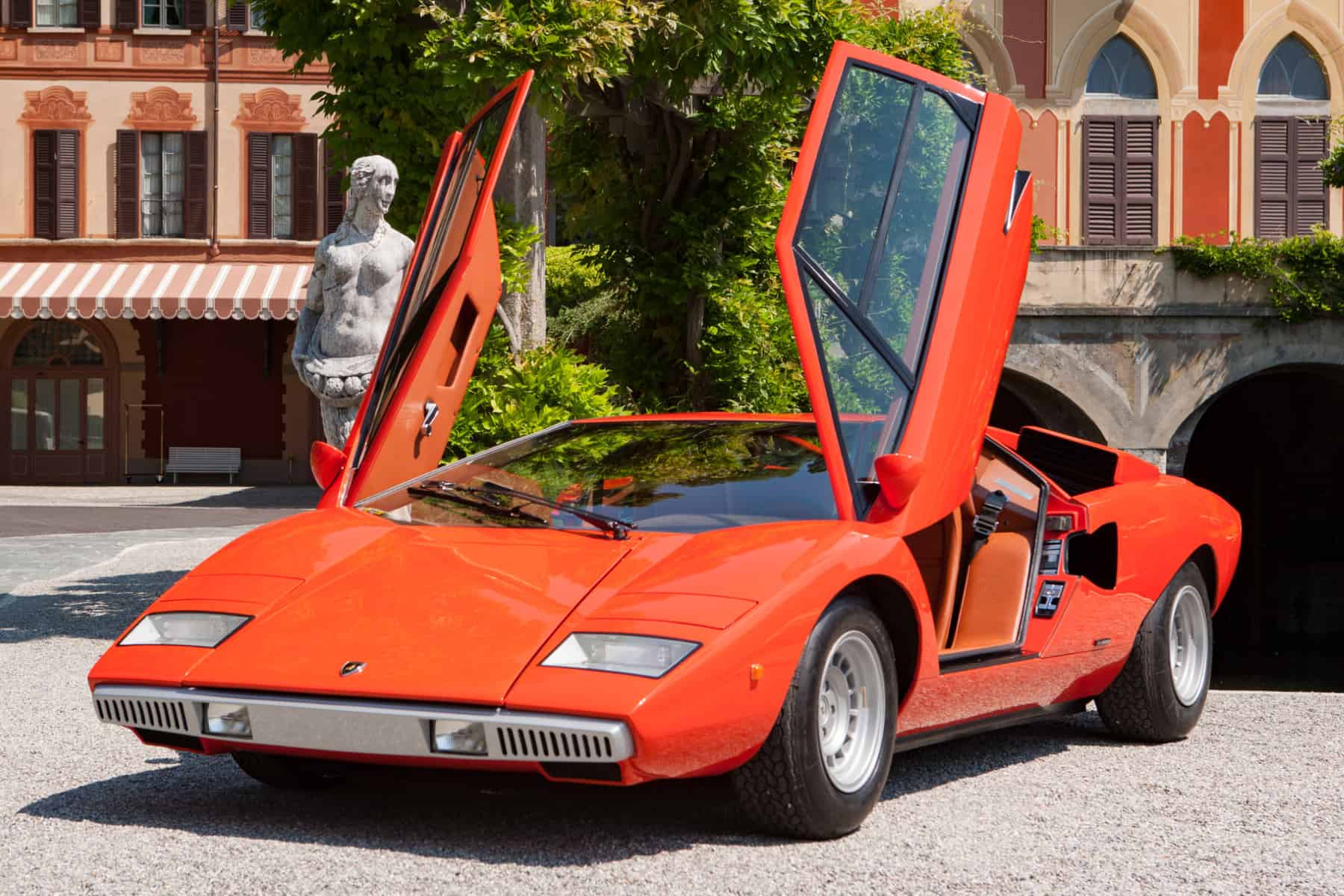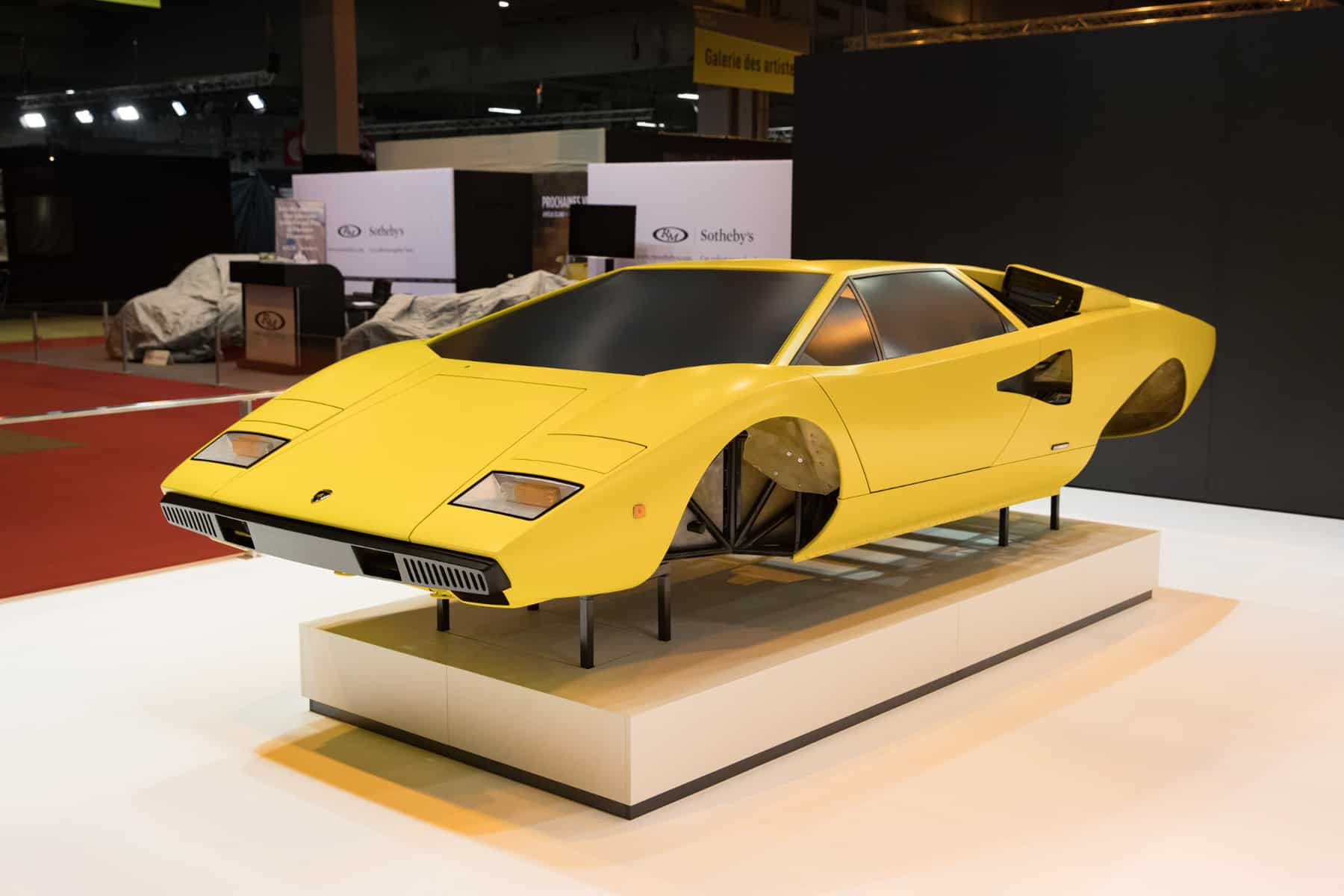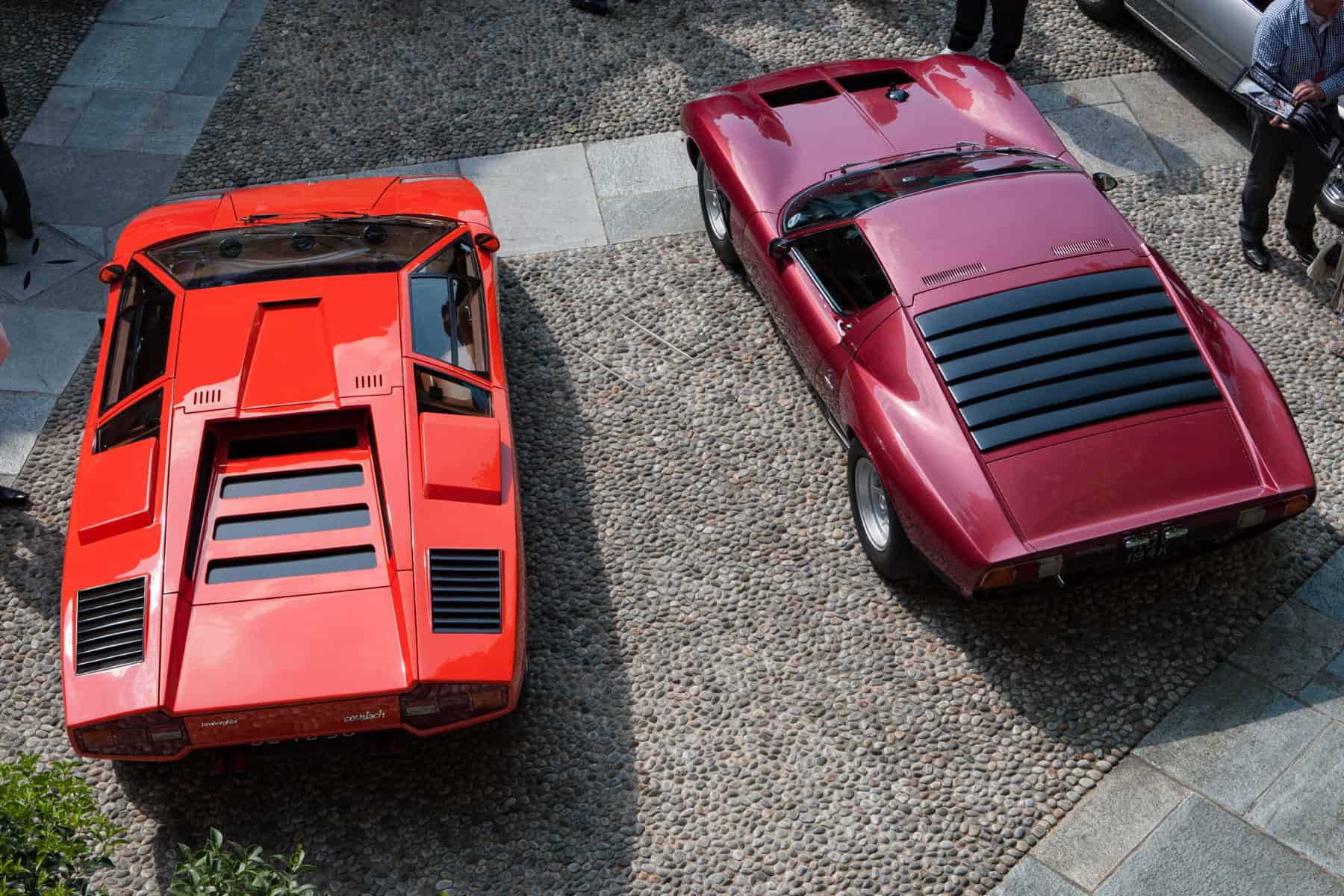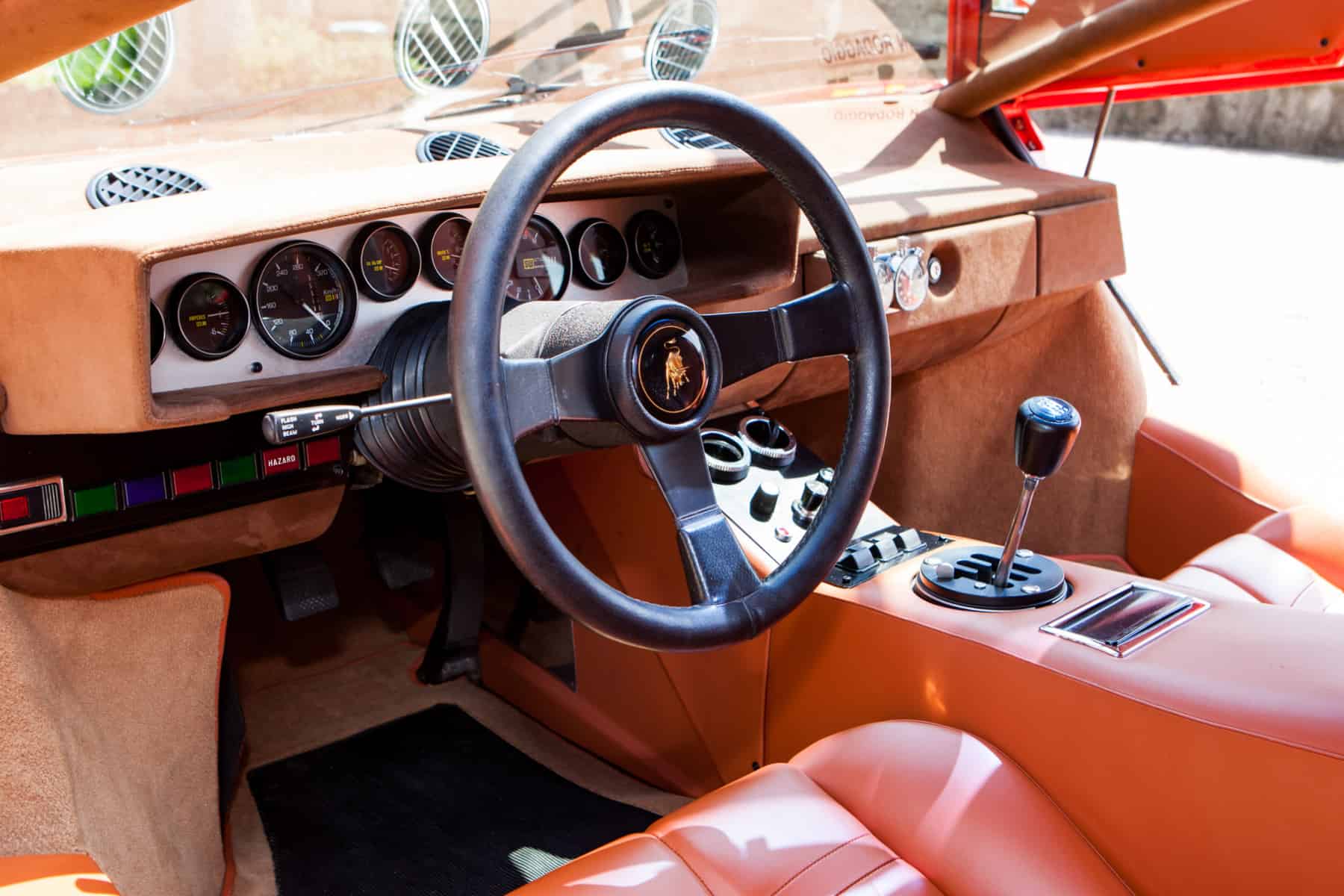Lamborghini Countach
Fifty years on, Marcello Gandini’s marvel still astonishes
BY: WOUTER MELISSEN
“A piece of wood, rubber, metal, etc. with one thick end and one thin, pointed end that you use to keep a door open, to keep two things apart, or to split wood or rock.” This is the dictionary definition of a “wedge.”
But for many of us, our first association with the word may be with 1970s supercars like the Lamborghini Countach. Designed for Italian carrozzeria Bertone by Marcello Gandini, this ground-breaking machine was first shown in concept form fifty years ago this year at the 1971 Geneva Motor Show.
Known internally as Project 112, the Countach was developed as a replacement for the Lamborghini Miura, which, in 1966, was the first mid-engined supercar to enter production. The 4.0-liter, V12-engined machine was also a collaboration between Lamborghini and Bertone. It featured elegant lines that were penned by Giorgietto Giugiaro and Marcello Gandini. The chassis was the work of Gian Paola Dallara and the transversely mounted, twelve-cylinder engine had originally been created by Giotto Bizzarrini. With so many talented engineers involved, it was no surprise that the Miura was well ahead of its time.
Rival manufacturers were catching up and Ferruccio Lamborghini tasked his men to create a replacement for the Miura earlier than expected. Dallara had left to join DeTomaso, and his replacement Paolo Stanzani started the development of a new chassis in 1970. At the same time, the services of Bertone were called in once again. Whereas the previous Lamborghinis had all been relatively understated, elegant designs, Ferruccio Lamborghini was adamant that the Miura replacement had to be altogether more striking. Gandini was definitely the right person for the job as he was an early adaptor of the futuristic wedge design.
A first sign of things to come was the Alfa Romeo Carabo show car that was unveiled at the 1968 Paris Motor Show. Just two years after the Miura had entered production, the future had arrived. Gone were the curves and flowing lines, instead the Carabo sported sharp lines and flat surfaces. There was virtually a straight line from the tip of the nose to the leading edge of the roof. Gandini included scissor doors and pop-up headlights in the design. The Carabo name was a reference to the Carabidae beetle, which had a similar metallic green color. Two years later, Gandini and Bertone also produced the Lancia Stratos Zero, which was an even more extreme wedge.
Design influences of these two show cars were combined to form what would become the Countach LP500, which was first shown to the public in 1971. Like the earlier Carabo and Stratos Zero, the new Lamborghini was a combination of flat surfaces with sharp lines. Like a wedge, it was thin at the nose and then a single line ran straight up to the leading edge of the roof with the cockpit forming the thick part. The nose panel featured a subtle recess to allow for fresh air to be fed in the cockpit and there were more substantial recesses in the roof and the engine cover that added some spice to the flat surfaces. Another interesting cue was the elliptical shaped cut-out for the rear wheels.
The indentation in the roof was functional, as it allowed for a periscope-style rearview mirror, which, in theory at least, should provide a superior view behind than through the tiny rear window. Still very much a show car, no wing mirrors were fitted on the Countach LP500. As on the Carabo, access to the cockpit itself was through scissor doors that hinged up instead of out at the A-pillar. This allowed for the car to be slightly wider without causing an issue with opening the doors in tight spaces. Due to the sharp angle of the side windows, it was impossible to slide down the complete window. Instead only a small section of the window could be rolled down for some additional fresh air. Matching the modern exterior was an equally futuristic dashboard with electronic instruments.
While its futuristic design suggested the Countach LP500 was a show car, it was indeed intended to be fully functional and featured a bespoke platform chassis and drivetrain. The latter was referenced in the LP500 type name, as the Countach boasted a 5.0-liter version of the V12 engine that was mounted longitudinally behind the driver or Longitudinale Posteriore in Italian. In a conventional longitudinal layout, the gearbox would be mounted behind the rear axle but that would result in a very long rear overhang. Stanzani created an ingenious work-around by placing the gearbox ahead of the engine underneath the transmission tunnel. The rear wheels were driven by a shaft that ran through the V12’s engine block.
It has been a long-standing Lamborghini tradition to name the company’s cars after a famous fighting bull; the Countach is a rare exception. It is in fact an expression of astonishment and admiration in a Piedmontese dialect, Piedmont being the region in Italy where the Bertone factory was based. Exactly who first used the word Countach around the new mid-engined Lamborghini is a subject of much debate. Some suggest it was Nuccio Bertone himself who exclaimed Countach when he first saw the car in the metal, while Gandini suggested in his biography that it was one of Bertone metal workers, who only spoke in this particular dialect and regularly used the word while working on the car. A completely different story is that it was the expression of a farmer who came across the car, which apparently had been hidden away during one of Italy’s numerous labor unrests in order to prevent delays. Regardless, Countach was very appropriate for the car and the name stuck.
There were undoubtedly many more, similar expressions of amazement and admiration uttered around the car at the 1971 Geneva Motor Show. Encouraged by the great reception at the Countach debut, the development of the production version started shortly thereafter. Indeed a fully functional machine, the Geneva show car was entrusted to test driver Bob Wallace. He subjected it to numerous trials to figure out just what had to be done before the Countach could hit the market. An issue that almost immediately revealed itself was engine cooling. The Countach sported shark-gill like intakes on the rear fenders but these were found to be insufficient. Larger scoops were added on top but it still was not enough, with a comprehensively blown engine as the result.
To make the new 5.0-liter engine sufficiently reliable was a task that Lamborghini were not ready to undertake at this time, so Stanzani and his team opted to use the tried and trusted 4.0-liter engine for the production car. Still based on the original Lamborghini V12 engine designed a decade earlier by Giotto Bizzarrini, the all-aluminum unit featured twin overhead camshafts and two valves per cylinder. Mounted flat between the intake and exhaust camshaft were three 45 mm Weber carburetors for each bank of six cylinders. For the “Countach LP400” production car, it was tuned to produce around 370 hp at 8,000 rpm. As on the show car, the five-speed manual gearbox was mounted ahead of the engine and protruded well into the cockpit.
For the Countach LP500 show car / prototype, Stanzani had produced an all-new steel platform chassis that used the exterior panels as stressed members. This was completely discarded for the production car, as from the second prototype onwards a more conventional steel spaceframe chassis was used. This allowed the body panels to be made from lightweight aluminum instead of steel. Despite using a completely different chassis as the production car, the original prototype eventually came to its demise as part of the crash test program required to certify the Countach for the road. As was the norm for high-performance machinery of the day, the Countach featured all-round independent suspension and discs brakes on each corner.
The Lamborghini and Bertone engineers were very successful in retaining the iconic wedge shape of the show car. There were detail changes of course but the pop-up headlights, scissor doors and periscope rear-view mirror were retained. Accordingly, the first Countachs built are now commonly referred as the Periscopia model. Despite reverting to the smaller engine, cooling remained an issue and the shark-gill intakes on top of the fenders did not return. Large scoops were used, which were really the only compromise made to the pure lines of the original design. The futuristic electronic dashboard was not carried over and conventional dials were fitted. There was just enough space inside the low and tight cockpit to seat two adults, who were separated by a sizable transmission tunnel.
Two years after the original launch, Lamborghini returned to Geneva with the production version of the Countach. Originally painted red, this car was chassis 1120001 and it was later repainted green before it was also shown in Frankfurt, Paris, and London. Production of the Countach LP400 started in earnest in 1974 and benefitting from several evolutions, it would remain in production until 1989, by which time nearly 2,000 examples were built. Although very much a production car, the Countach probably was never intended as a daily driver. Much to his credit, Gandini remained true to the original design with relatively little consideration for creature comforts like a peripheral view. As a result, the well adapted technique for reversing in a Countach, for example, is to sit on the sill with the door open and look over the roof. Fortunately, although creature comforts are ranked fairly low on the check list for a mid-engined supercar, the Countach certainly ticks all other boxes.
There are few cars that exemplify the 1970s better than the original Lamborghini Countach. To be fair, the later versions with the wider fenders and massive rear wing were also right at home in the 1980s. The Countach is not just a design icon, it would lay the foundation for the subsequent V12-engined Lamborghinis, which all used the centrally mounted gearbox and the scissor doors first used on the 1971 Countach LP500 show car.
Update: After this story posted, the editors heard from one of our regular writers, Ken Gross, who noted, “on Sunday, August 15, 2021, the Pebble Beach Concours d’Elegance will celebrate the Fiftieth Anniversary of the Lamborghini Countach with a special Countach Anniversary Class. Eight Countach’s will be on the field, including the last Anniversary Countach built, which is still owned by the Lamborghini factory.”












